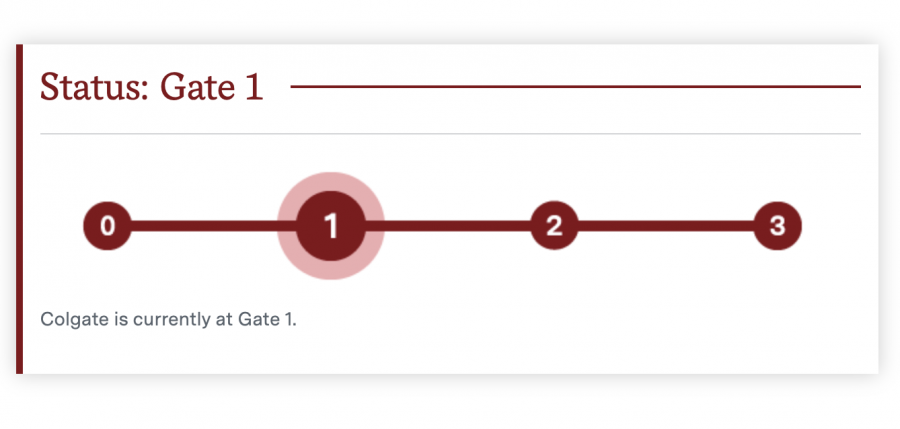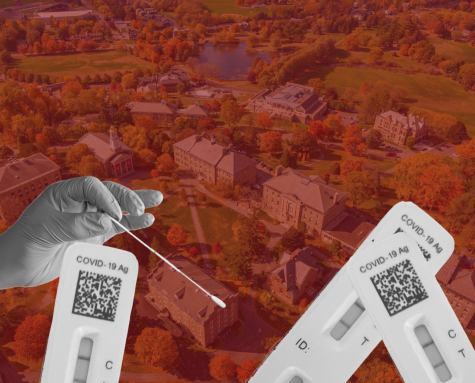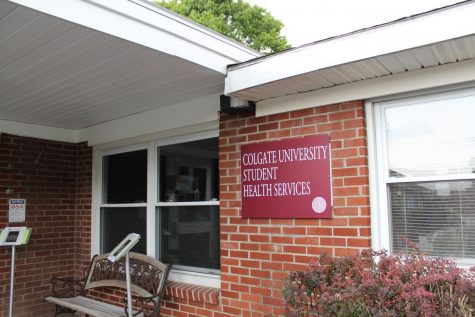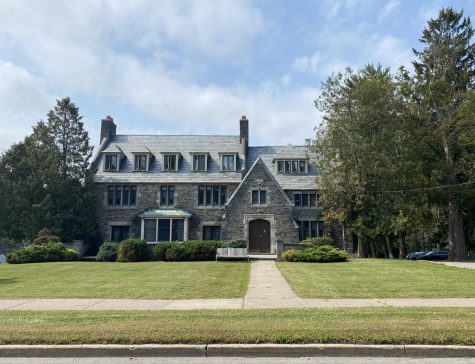University Enters Gate 1 of Reopening
Upon completing Gate 0 of Reopening, Colgate’s universal quarantine that began upon the arrival of students to campus, the University entered Gate 1 last Tuesday, Sept. 8 at 7 a.m.
The Task Force on the Reopening of the Colgate Campus developed the series of four Gates, numbered zero through three, “to establish the ways in which Colgate will seek to maintain health and safety as we progress through this semester,” according to the University’s website.
Task Force co-chair and Associate Professor of Biology Geoff Holm said the plan to reopen the campus in Gates stemmed from the same logic behind the phased reopenings of many states.
“The Gates are really to phase that opening so that we can continue to gauge what the infection level is in the population before having lots of interactions so that we have the best chance of being able to contain it going forward,” Holm said.
According to Holm, the universal two-week quarantine was meant to reduce the number of COVID-19 cases on campus to a low level, if not eliminate cases entirely. But, members of the Task Force were aware that a number of scenarios—such as low levels of the virus or unidentified close contacts—could result in cases after Gate 0.
“Rather than having a situation where we, after quarantine, opened the campus up to lots of people interacting across different residence halls, across different parts of the campus—which could then take those undetected cases and spread them widely in the population—we decided that the most conservative approach would be to open things up but still try and keep those family units together as much as possible [and] prevent people from different residential areas from interacting in ways that could spread the virus,” Holm said.
Gate 1 allows for limited in-person activity, always with physical distancing of six feet and face coverings. Outdoors, this includes gatherings of 10 people or fewer from as few family units as possible and outdoor classes. Indoors, students may enter supervised spaces such as libraries and classrooms, socialize with extended family units in common rooms within students’ own residence halls, and eat in dining halls. Students may also go into the Village of Hamilton in Gate 1 in groups of four or fewer, abiding by the rules of downtown businesses.
“It was nice to feel like we’re taking another step towards the normal Colgate experience,” sophomore Geddy Rerko said of the transition to Gate 1. “The University has done a great job of making that possible. I noticed that throughout quarantine, so many lengths were went to to make sure that things were done so we could stay.”
All classes operated online for the two-week quarantine period, but Gate 1 marks a return to in-person instruction for in-person and hybrid classes. For some, this means physically-distanced learning inside rearranged classrooms. In-person learning may also take place in outdoor tents or non-traditional classrooms throughout campus and the Village.
Visiting Assistant Professor of Political Science Rachelle Walker chose to teach her three courses in-person this semester, citing her confidence in Colgate and some students’ need for in-person instruction as factors in her decision. Walker teaches all three of her courses in the Thought Into Action (TIA) building in Hamilton’s village center.
“I think that overwhelmingly, the most amazing thing about doing in-person has been just how hard the IT department and buildings and grounds [worked] to get this set up,” Walker said. “Because so many people at Colgate worked so hard and showed so much creativity in getting the classroom spaces put together, it made the transition work instead of just absolutely fall[ing] apart, because that could have happened too.”
Walker also attributes part of the success of in-person classes to her students.
“I’ve been really thankful because I’ve noticed that students have really worked hard and shown a lot of maturity in filling in gaps,” Walker said. “My remote students have worked really hard to make sure that they’re connected to the classroom [and] my in-person students have been really positive about any kinds of adaptations we need to make in the classroom.”
For Walker, moving from online to in-person initially felt as though the class was starting over, and lecturing a mask proved more difficult than she expected. She added, however, that she has received positive feedback from students indicating that instruction in the classroom and on Zoom has been effective and clear.
Rerko said she felt excited about the transition from online classes during quarantine to in-person instruction.
“Being able to go into in-person classes has probably been one of my favorite things because that is why we’re all here. We all want to learn and be able to go to our in-person classes so when the opportunity came, I know I, among others, [was] excited for that,” Rerko said. “It’s just been nice being able to walk around outside, feel like something’s somewhat normal.”
While Gate 1 allows for more activities than were permitted during the quarantine, the transition does not mark a return to the type of life on campus that many returning students might be used to, as expressed by sophomore Meg D’Souza.
“[The transition to Gate 1 has] been less exciting than I expected, because it’s not how things were in the spring or last year,” D’Souza said. “It’s still not the same, especially because there are so many…little experiences that make Colgate Colgate that we still don’t get to have.”
This altered campus life has caused some concern about student behavior, according to Holm.
“As we’ve said all along, we are bringing students back to campus, but not to the campus that they knew previously,” Holm said. “The worry was that people would revert back to the way that they had been interacting last year, and that’s the problem piece. That type of behavior is our biggest concern for spreading the virus.”
According to an email sent on Thursday, Sept. 10 by Vice President and Dean of the College Paul McLoughlin and Provost and Dean of the Faculty Tracy Hucks, 18 students have been required to complete the remainder of the fall semester remotely as a result of violations to the Commitment to Community Health, which all students returning to campus were required to read and sign.
In a ‘Colgate Digest’ email sent by Vice President for Communications Laura Jack on Monday, Sept. 14, Jack stressed the number of violations related to mask-wearing that occurred last weekend. The email stated that each violation will be documented and students and their parents/guardians will be warned that further violations of the Commitment to Community Health will result in the student’s return home.
“I am extremely concerned. I do not think that people are following all of the rules,” D’Souza said. “More than half of the people that I see don’t cover their noses with their masks, which defeats the point… I think that people forget that wearing a mask properly and social distancing go hand-in-hand in staving off the pandemic.”
Large gatherings of students pose a serious threat to community health, according to Holm.
“The thing that’s going to shut us down is not a roommate passing it to a roommate, or a roommate passing it to a friend,” Holm said. “But an individual going to a large gathering and infecting a lot of people that then take it to lots of different places on campus and then initiate chains of infection.”
Holm said that it was too early to tell when the Task Force will be making the decision to move to the next Gate or if Colgate is on track to enter Gate 2 next week after a full 14 days in Gate 1, the minimum time to be in a Gate before proceeding to the next. This week’s round of surveillance testing of six percent of the on-campus population will be an important factor in this decision, according to Holm.
“The behavioral piece is also really important because if we see…people congregating in large groups without wearing masks, that’s certainly a factor in our decision to go to Gate 2,” Holm said. “Because if those types of events are happening at an even a fairly low rate, that’s still increasing our risk for transmission considerably.”
The University may enter Gate 2 “if health metrics remain at low levels or new normal levels during Gate Level 1 for a minimum of 14 days,” according to the Colgate website.
“I want people to take things seriously and still understand the gravity of the situation that we’re in, and that it’s bigger than ourselves,” Rerko said. “We aren’t just worrying about ‘my health, myself,’ but we’re worrying about other staff on campus and we’re worried about roommates, floormates, classmates and all of those people too.”

Josie Rozzelle is a senior from San Francisco, CA concentrating in political science with a minor in French. She has previously served as multimedia manager,...










